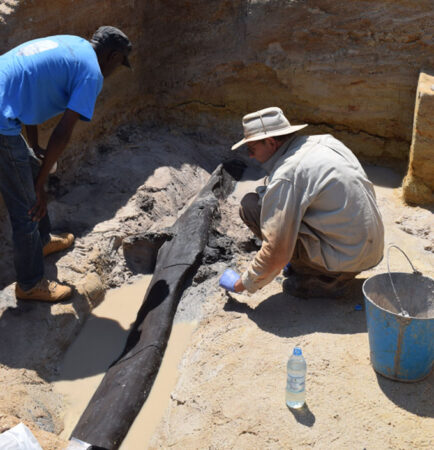This post was originally published on this site
Modified logs dating to about 476,000 years ago might be the oldest evidence of wooden structures, a new study finds.
Wooden artifacts decompose easily and are relatively scant in the archaeological record compared with stone or bone. The new finding, reported September 20 in Nature, suggests that the structural use of wood may stretch far back into the history of human ancestors, hinting at advanced cognitive skills and a less nomadic lifestyle for some hominids than previously thought.
“It’s a challenge to preconceptions about what are considered sophisticated, complex behaviors,” says Larry Barham, an archaeologist at the University of Liverpool in England. “For me, settling into one place and changing the landscape, that is very sophisticated.”
Humans and their ancestors have been using wood in some fashion for quite some time. The earliest known example of modified wood is a polished plank from Israel dating to around 780,000 years ago. Wooden tools don’t appear in the historical record until about 400,000 years ago. Before this new study, the earliest known example of a wooden structure was much more recent: around 9000 B.C.
During a dig in 2019, Barham and colleagues found five modified wooden objects in the exposed bank of a river flowing into the top of Kalambo Falls in Zambia. The area is rich with forest and has a consistently high water table. This makes it ideal for human habitation — and the water also blocks oxygen from buried wood. Since the 1950s, archaeologists have excavated ancient technologies here, though wooden objects couldn’t be accurately placed in time and clear modifications had been worn away.
This time the team used a technique known as luminescence dating (SN: 7/19/17). Minerals buried underground gradually absorb background radiation like a battery taking up charge, which can be released later as light. This reveals how many years ago a sample last saw the sun. The team analyzed 16 sand samples‚ including from directly around the wooden objects, and grouped the artifacts into three chunks of time from 476,000 to 324,000 years ago.
In the sands that are nearly half a million years old, the team found two large interlocking logs, with shaped ends and wide, carved notches at the point they overlap. Like an early version of Lincoln Logs, this would have held the wood together. Both logs showed evidence of chopping and scraping, and were buried near tools used for scraping or carving, hand axes and other crafting equipment.

These logs may have been part of a structure — a raised walkway, a place to store wood or somewhere to sit — that helped early hominids in their environment, the researchers suggest. Based on timing and location, the structure could be the handiwork of Homo heidelbergensis, a human ancestor that lived about 700,000 to 200,000 years ago. Other wooden objects recovered from the site include a wedge, a digging stick and a chopped log, dating from 390,000 to 324,000 years ago.
“This paper provides a wonderful peek into our past,” says Rebecca Biermann Gürbüz, a biological anthropologist at the University at Buffalo in New York who was not involved in the study. Other primates use wood and plants in a variety of ways, she says. “So the fact that [hominids] did so nearly half a million years ago is not surprising.”
In fact, Barham wonders if Stone Age is even the right term for that era. “Let’s say wood survived as much as bone does in the archaeological record,” he says. “Maybe we should relabel our Stone Age to the Woodworking Age, an Organic Age or something that reflects the reality of common behavior, which we can only really glimpse.”
